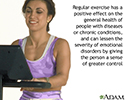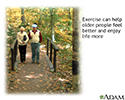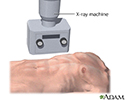Multimedia Gallery
Foot pain
Healthy feet often travel miles each day. You use them to get up and down supermarket aisles, climb stairs, and walk on the treadmill, among other things. Any pain or discomfort in your feet can really slow you down and impact your life. Let's talk about foot pain, and what to do if you have it.
A lot of different things can cause foot pain, including those stiletto heels you couldn't resist passing by the shoe store window at the mall. Wearing poorly fitting or high-heeled shoes day after day can squeeze and pinch your feet until they start to hurt.
For example, shoes that are too narrow can cause bunions, swollen bumps at the base of your big toe. Wearing shoes that are too tight can curl your toes until they look like a claw. That's called a hammer toe. When your feet rub against your shoes, you can get areas of thickened skin called calluses or corns. And too much pressure from your shoes on the soles of your feet can create an opening for a viral infection called plantar warts.
If your shoes aren't a problem, you may have one of several conditions that cause foot pain. Arthritis, a fractured or broken bone, gout, tendinitis, plantar fasciitis can all make your feet hurt. You're more likely to have foot problems as you get older and your joints wear down. Being overweight puts extra pressure on your feet, which can also lead to pain.
So, what do you do if your feet hurt?
That depends on what's causing your pain. Sometimes you can treat foot pain at home. For example, you can hold ice to your foot to bring down swelling, and take an over-the-counter pain reliever such as ibuprofen or acetaminophen. Try to keep off the painful foot as much as you can. Sit with your feet raised until they start to feel at least a bit better. Wearing foot pads and other shoe inserts may also help your feet heal and prevent future pain.
Sometimes you'll need to see a doctor, especially if the pain is due to an injury, or it's severe, or it hasn't improved after a couple of weeks of treatment at home. Your podiatrist can examine your feet, diagnose the problem, and remove any growths like warts, corns, or calluses. A foot doctor can also treat a broken or fractured bone. Depending on how serious the problem is, you may even need surgery to treat it.
There are ways to prevent foot pain before it can start-like being careful when you exercise. Working out is great, but you never want to run or jump hard enough to damage your feet. Losing weight can also help take some of the pressure off of your feet.
Probably the kindest thing you can do for your feet is to wear comfortable shoes. Your shoes should fit properly, supporting and cushioning your feet while leaving plenty of room for your toes to wiggle around. So, when you're shoe shopping, leave the stilettos on the shelf, and reach for a comfortable, attractive option instead. Your feet will thank you by not causing you pain.
Foot pain
Review Date: 6/4/2025
Reviewed By: C. Benjamin Ma, MD, Professor, Chief, Sports Medicine and Shoulder Service, UCSF Department of Orthopaedic Surgery, San Francisco, CA. Also reviewed by David C. Dugdale, MD, Medical Director, Brenda Conaway, Editorial Director, and the A.D.A.M. Editorial team.
Animations
- Ankle ligament injury
- Ankylosing spondylitis
- Anterior shoulder stretch
- Arm reach
- Arthritis
- Bone fracture repair
- Bunion
- Carpal tunnel syndrome
- Exercise
- External rotation with band
- Fibromyalgia
- Foot pain
- Heel pain
- Herniated disk
- Herniated nucleus pulposus ...
- Hip joint replacement
- How to use a pill cutter
- Internal rotation with band
- Isometric
- Knee joint replacement
- Multiple sclerosis
- Neck pain
- Osteoarthritis
- Osteoarthritis
- Osteoporosis
- Osteoporosis
- Pendulum exercise
- Plantar fasciitis
- Rheumatoid arthritis
- Rotator cuff problems
- Sciatica
- Scoliosis
- Shoulder blade retraction
- Shoulder blade retraction w...
- Shoulder joint dislocation
- Shoulder pain
- Spinal stenosis
- Stretching back of your shoulder
- Up the back stretch
- Vacation health care
- Wall push-up
- Wall stretch
- What is tennis elbow?
Illustrations
- ACL degrees
- ACL injury
- Active vs. inactive muscle
- Aerobic exercise
- Ankle anatomy
- Ankle sprain
- Ankle sprain swelling
- Anterior cruciate ligament ...
- Anterior skeletal anatomy
- Arthritis in hip
- Aseptic necrosis
- Baker cyst
- Benefit of regular exercise
- Blood supply to bone
- Blood test
- Bone biopsy
- Bone density scan
- Bone graft harvest
- Bone tumor
- Bone-building exercise
- Bursa of the elbow
- Bursa of the knee
- Bursitis of the shoulder
- Calcium benefit
- Calcium source
- Calculating body frame size
- Calories and fat per serving
- Carpal biopsy
- Carpal tunnel surgical procedure
- Carpal tunnel syndrome
- Cauda equina
- Central nervous system
- Central nervous system and ...
- Cervical spondylosis
- Cervical vertebrae
- Changes in spine with age
- Chest stretch
- Chondromalacia of the patella
- Clubfoot deformity
- Colles fracture
- Common peroneal nerve dysfu...
- Compression fracture
- Compression of the median nerve
- Congenital hip dislocation
- Contracture deformity
- Corns and calluses
- CREST syndrome
- CT scan
- Damaged axillary nerve
- Dislocation of the hip
- Early treatment of injury
- Elbow - side view
- Electromyography
- Ewing sarcoma - x-ray
- Exercise - a powerful tool
- Exercise and age
- Exercise and heart rate
- Exercise can lower blood pr...
- Exercise with friends
- External fixation device
- Fast food
- Femoral fracture
- Femoral nerve damage
- Fibromyalgia
- Fish in diet
- Foot swelling
- Forward bend test
- Fracture types (1)
- Fracture types (2)
- Fracture, forearm - x-ray
- Fractures across a growth plate
- Groin stretch
- Hammer toe
- Hamstring stretch
- Head trauma
- Healthy diet
- Herniated disk repair
- Herniated lumbar disk
- Herniated nucleus pulposus
- Hip fracture
- Hip stretch
- Hunger center in brain
- Hypermobile joints
- Impingement syndrome
- Inflamed Achilles tendon
- Inflamed shoulder tendons
- Internal fixation devices
- Intervertebral disk
- Isometric exercise
- Joint aspiration
- Knee arthroscopy
- Knee joint
- Knee joint replacement pros...
- Knee pain
- Kyphosis
- Lateral collateral ligament
- Lateral collateral ligament...
- Lateral collateral ligament pain
- Leg pain (Osgood-Schlatter)
- Leg skeletal anatomy
- Limited range of motion
- Location of whiplash pain
- Lordosis
- Lower leg edema
- Lower leg muscles
- Lower leg muscles
- Lumbar vertebrae
- Lupus - discoid on a child'...
- Lupus - discoid on the face
- Lupus, discoid - view of l...
- Medial collateral ligament
- Medial collateral ligament ...
- Medial collateral ligament pain
- Meniscal tears
- Metatarsus adductus
- MRI scans
- Muscle biopsy
- Muscle cells vs. fat cells
- Muscle pain
- Muscle strain
- Muscular atrophy
- myPlate
- Neck pain
- Nerve biopsy
- Nerve conduction test
- Normal foot x-ray
- Normal knee anatomy
- Nuclear scan
- Osteoarthritis
- Osteoarthritis
- Osteoarthritis vs. rheumato...
- Osteogenic sarcoma - x-ray
- Osteomyelitis
- Osteoporosis
- Osteoporosis
- Patellar dislocation
- Physical activity - prevent...
- Plantar fascia
- Plantar fasciitis
- Posterior cruciate ligament...
- Posterior spinal anatomy
- Psoriasis - guttate on the ...
- Psoriasis - guttate on the cheek
- Radial head injury
- Radial nerve dysfunction
- Raynaud's phenomenon
- Reactive arthritis - view o...
- Retrocalcaneal bursitis
- Rheumatoid arthritis
- Rheumatoid arthritis
- Rheumatoid arthritis
- Rheumatoid arthritis
- Rotator cuff muscles
- Runners knee
- Sacrum
- Sciatic nerve
- Sciatic nerve damage
- Sclerodactyly
- Scoliosis
- Scoliosis
- Scoliosis brace
- Shin splints
- Shoulder arthroscopy
- Shoulder joint
- Shoulder joint inflammation
- Shoulder sling
- Signs of scoliosis
- Skeletal spine
- Skeleton
- Smashed fingers
- Spinal anatomy
- Spinal cord injury
- Spinal curves
- Spinal fusion
- Spinal stenosis
- Spinal stenosis
- Spinal tumor
- Spine supporting structures
- Sprained ankle
- Superficial anterior muscles
- Surface anatomy - normal palm
- Surface anatomy - normal wrist
- Synovial biopsy
- Synovial fluid
- Systemic lupus erythematosus
- Systemic lupus erythematosu...
- Tailbone (coccyx)
- Telangiectasia
- Tendinitis
- Tendon vs. ligament
- Tendonitis
- Tendons and muscles
- The structure of a joint
- Thigh stretch
- Tibial nerve
- Tophi gout in hand
- Torn lateral collateral ligament
- Torn medial collateral ligament
- Torticollis (wry neck)
- Treatment for leg strain
- Triangular shoulder sling
- Triceps stretch
- Ulnar nerve damage
- Uric acid crystals
- Vertebra, cervical (neck)
- Vertebra, lumbar (low back)
- Vertebra, thoracic (mid back)
- Vertebrae
- Vertebral column
- Vitamin D source
- Weight loss
- Whiplash
- Wrist anatomy
- Wrist splint
- X-ray
- X-ray
- Yo-yo dieting
Presentations
- Ankle sprain - Series
- Anterior cruciate ligament ...
- Bone fracture repair - series
- Bunion removal - series
- Carpal tunnel repair - series
- Clubfoot repair - series
- Creating a sling - series
- Hand splint - series
- Hip joint replacement - series
- Knee arthroscopy - series
- Knee joint replacement - series
- Leg lengthening - series
- Lumbar spinal surgery - series
- Microdiskectomy - series
- Partial knee replacement - ...
- Rotator cuff repair - series
- Shoulder separation - series
- Spinal bone graft - series
- Spinal fusion - series
- Spinal surgery - cervical -...
- Two person roll - series

 Bookmark
Bookmark


























































































































































































































































































